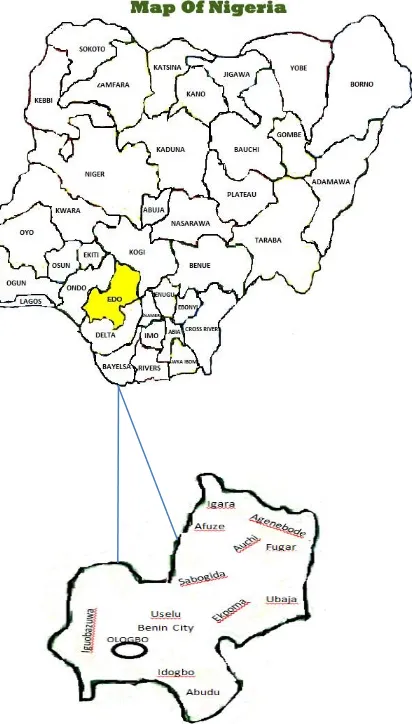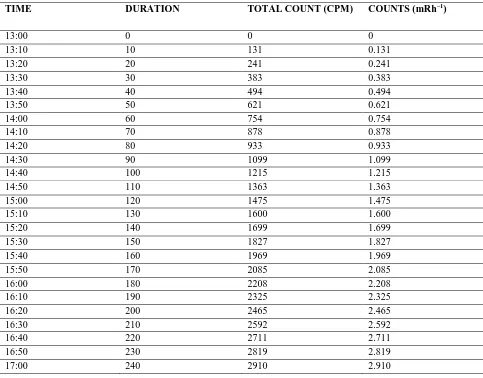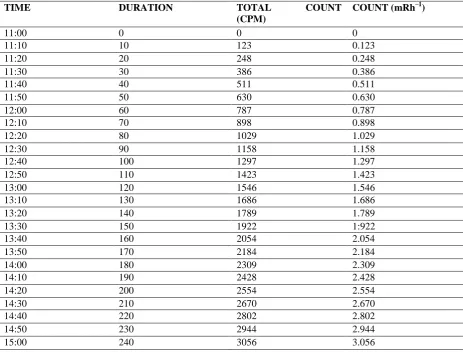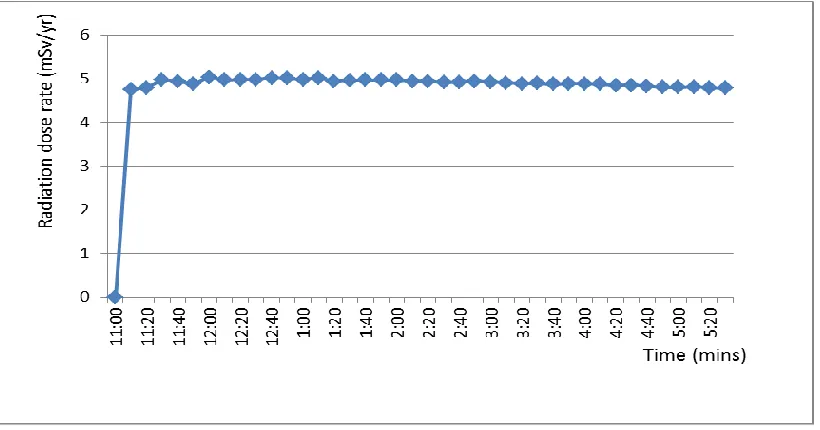99
IN SITU MEASUREMENTS OF ATMOSPHERIC GAMMA RADIATION IN THE
GAS FLARING ENVIRONMENT OF THE OLOGBO TOWN, NIGERIA.
Onosohwo, B.U.¹; Mangset, E.W.² and Khandaker, M.U.¹*
¹ Department of Physics, University of Malaya, 50603 Kuala Lumpur, Malaysia. ² Department of Physics, University of Jos, Plateau State, Nigeria.
Corresponding author. E-mail: mu_khandaker@yahoo.com, Tel.: +60379674099; Fax: +60379674146.
ABSTARCT The atmospheric gamma radiation level in gas flaring environment has gained the attention of researchers and environmentalists due to its devastating impact both on the climate and the environment. It is important to make a quantitative assessment of the gamma radiation in the gas flaring environment and nearby residential areas. In situ measurements of the gamma radiation were performed using a nuclear radiation monitoring device: Digilert-50, Stop watch and a geographical positioning system. Data were collected from two different locations: Ologbo town and 40m away to the flaring site. Measured data showed that the mean equivalent dose rate at 40m away to the flaring site during flaring period was 1.02mSv/yr, and at Ologbo town was 1.04mSv/yr. The obtained dose rate in the flaring site and Ologbo town area exceeded the International Atomic Energy Agency and International Commission on Radiological Protection recommended safety limit (>1mSv/yr.) for the general public. This shows that the flaring activities have impacted the surrounding environment radiologically. This may pose long-term health side effects on the workers and residents of the host communities. We recommend that flaring should not be done where human population is high or near residential areas because of the radon gas released.
(Keyword: Gas flaring, Ologbo town, Atmospheric gamma radiation, In-situ measurements, General public)
INTRODUCTION
Natural gas is the single phase of petroleum. Global natural gas demand shows rapid increasing trend due to large scale urbanization, specifically in the developing countries. Natural gas, which was once an embarrassing and unwanted by – product or more correctly a co–product of crude–oil production, now provides about one–fifth of all the world’s primary energy requirements [1]. Contamination of oil and gas facilities with natural radionuclide is widespread. Both oil and gas are generally contaminated with the 238U and 232Th decay series radionuclides in the rock reservoir. Contamination with radium is common in oil – production facilities whereas contamination with radon and radon decay products is prevalent in natural gas production and processing facilities, such as gas wells, pipelines and other gas processing facilities [2]. Moreover, the processing of petroleum containing naturally occurring radioactive materials (NORMs) via mechanical, chemical or thermal treatment methods can disrupt radioactive equilibrium due to the separation of different radionuclides into various process streams. Once separated from the primordial parents, the longer-lived radionuclides of the 238U and 232Th series can form their own sub-series, headed by
226Ra and 228Ra [3]. Therefore, some contamination
may be sufficiently severe; as a result the maintenance and other personnel may be exposed to hazardous concentrations. Radioactive
100
changes and the occurrence of lung cancer [5]. Two of its radioactive decay products, 218Po and 214Po, impact the majority of radiation dose to the lungs rather than the radon itself. Everyone is exposed in daily life to radon, a chemically inert radioactive gas that occurs naturally and is present everywhere [6]. A number of studies have suggested that long –
term exposure to radon gas may be an important cause of Lung cancer [7]. In addition, they are exposed to alpha (~4.871MeV) and gamma radiation released during the decay of 226Ra and the low energy beta particles (~0.046MeV) released by the decay of 228Ra (Gamma radiation can also penetrate the skin and cause the risk of cancer) [8].
Only a few earlier studies [9, 10, 11] were carried out leading to the assessment of radiation doses in the periphery of Nigerian Oil, Gas and Petroleum
processing fields. [9] Studied the variation in well – head gamma radiation levels at the NPDC oil field in Ologbo, and reported fairly higher values than the normal background level but in agreement with the IAEA’s standard on ionizing radiation background level. [10] Assessed gamma – radiation profile of oil and gas facilities in selected flow stations in the Niger – Delta region of Nigeria and reported higher radiation levels at gas facilities than the oil facilities. [11] Studied the gamma – radiation levels in selected oil spilled areas in Rivers State, Nigeria and reported higher equivalent dose rate than the maximum permissible limit recommend by ICRP. However, since there is no study available on the measurement of atmospheric gamma radiation in the gas flaring environment of NPDC flaring site Ologbo, this now laid credence to this study.
101
Moreover, the fear and agitations of workers in this flaring environment and host community in the region on their health safety due to the proximity of the oil facilities to the host community make this research work most timely. Note that, data regarding levels of natural radioactivity and their corresponding radiation doses to the population are still lacking in the studied gas flaring environment. Therefore, the aim of this study is to investigate the potential health hazards posed to workers and the general public in the gas flaring environment of the NPDC oil field in Ologbo. The obtained data will provide essential and additional radiological information for the general population of the host community. The result will also give a baseline data for future detail studies on the atmospheric gamma radiation impacts in a gas flaring environment.
MATERIALS AND METHODS
Geological settings of the studied area
Nigeria, one – third larger than Texas and the most populous country in Africa, is situated on the gulf of Guinea in West Africa. Its neighbours are Benin, Niger, Cameroon and Chad. The lower course of the Niger – River flows south through the Gulf of Guinea. Swamps and mangrove forests border the southern coast; inland and hardwood forests [12]. The study area is a town/village or other agglomeration of buildings where people live and work in the country of Nigeria. It centre lies at a latitude 6˚3’ 8.04”N and longitude 5˚39’ 51.25”E and it has an elevation of 16 meters above sea level. It is a place with small population in the state of Edo state; Nigeria which is located in the region of Africa. The cities, town and places near Ologbo include Ugbenu, Okuku and Igbobaye. The major occupation of the inhabitants of this area is farming.
Gas flaring situations in Nigeria
Gas flaring refers to the burning of natural gas that is associated with crude oil when it is pumped up from the ground [13]. This associated gas is made up of two elements; carbon and hydrogen and is part of a family of chemical known as hydrocarbons [14]. Gas flaring harms the health of the people through
emissions that have been linked to cancers, asthma, chronic bronchitis, blood disorders and other diseases [15] especially people living close to a gas flaring site. There is confusion over how much oil and associated gas is produced in Nigeria. The most recent and independent information source suggest that over 3.5 billion standard cubic feet (scf) of associated gas was produced in 2000, of which more than 70% was flared [16]. Between 2012, SPDC installed associated gas gathering (ACG) infrastructure at 37 sites, covering about 66% of its associated gas production. Unfortunately, 18 of these facilities were either vandalized or not commissioned because of the crises in the Niger Delta between 2006 and 2010. SPDC also claimed that their flaring dropped by about 75% between 2003 and 2012 [17].
Data measurements.
Monitoring of the environmental radiation levels at the flaring station of the NPDC oil field at Ologbo in Edo State, Nigeria was carried out with a well calibrated digilert-50 nuclear radiation monitoring meter (S.E International, Inc. Summer town, USA), which contains a Geiger Muller tube capable of detecting Alpha, Beta, Gamma and X – rays with the temperature range from -100c to 500c while a geographical positioning system (GPS) was used to measure the precise location of sampling. An in situ approach of background radiation measurement was preferred and adopted to enable sample maintain their original environmental characteristics. The monitor was placed at about 2.0m away from the well head and 1.0m above the ground. The instantaneous total count was recorded every ten minutes interval while the cumulative count was monitored over a period of about 5 – 6 hours daily. Measurements were repeated for two selected days. From the data, the mean counts with time at each location were obtained. The meter usage and readings taken was carried out as reported by [9, 18]. Readings were obtained between 1100 hours and 1700 hours, since the exposure rate meters have the maximum response to environmental radiation within these hours as recommended by NCRP [19]. The count rate per minute recorded in the meter was converted to milli-roentgen per hour (mRh‒1) using the expression [18].
Count rate per minute (CMP) = 10‒3 roentgen × Q.F. (1) Where Q.F. is the quality factor, which is unity for external environment.
102
RESULTS AND DISSCUSION
Table I and II shows the results of the in situ measurements in the flaring area and non-flaring area, respectively. The flaring site (40m away) exposure rate ranged from 0.131mRh‒1 to 2.910mRh‒1 with a mean value of 1.472±0.832mRh‒1. The exposure rate at Ologbo town (2000m) ranged from 0.123mRh‒1 to 3.057mRh‒1 with a mean value of 1.537±0.868mRh‒1. The high value recorded at Ologbo town may be due to the spill of associated
crude and the exposure of effluent to the environment. The highest percentage deviation was recorded at the host community (Ologbo), which shows that the resumption of activities in the oil field has impacted the community significantly. Equivalent dose rate is the measure of the amount of radionuclides absorbed by the human body for a given period. ICRP recommended and consequently set the maximum permissible limit was set or non – radionuclide industrial worker and the public as 1.0mSvyr‒1[21].
Table 1. Gamma measurement in the Flaring site (40m away) Ologbo
TIME DURATION TOTAL COUNT (CPM) COUNTS (mRh‒1)
13:00 0 0 0
13:10 10 131 0.131
13:20 20 241 0.241
13:30 30 383 0.383
13:40 40 494 0.494
13:50 50 621 0.621
14:00 60 754 0.754
14:10 70 878 0.878
14:20 80 933 0.933
14:30 90 1099 1.099
14:40 100 1215 1.215
14:50 110 1363 1.363
15:00 120 1475 1.475
15:10 130 1600 1.600
15:20 140 1699 1.699
15:30 150 1827 1.827
15:40 160 1969 1.969
15:50 170 2085 2.085
16:00 180 2208 2.208
16:10 190 2325 2.325
16:20 200 2465 2.465
16:30 210 2592 2.592
16:40 220 2711 2.711
16:50 230 2819 2.819
17:00 240 2910 2.910
*Average count (mRh‒1) ± SD = 1.472±0.832, Where SD is Standard deviation
The mean radiation exposure rate at the flaring site during flaring was slightly lower than where there is no flaring. This is because the combustion product produced during flaring of natural gas will undergo certain recombination and association with the
103
radiation level within the host community which is also favoured by wind direction and the point of liberation. The flared ionizing radiations (radon gas) into the atmosphere precipitate upon condensing as rain water, thereby constituting radioactive rain water pollution. Unfortunately, this rain water serves as a major source of water for drinking and agriculture in the surveyed area, thereby increasing
the radionuclide dose intake by the host community. In addition, a great proportion of the rain water leaks from the oil / gas reservoir and carried to the sub – surface, where it can make contact with sea water. In the sea water, it partially precipitates, while the rest is consumed by the aquatic animals and hence poses a radiological risk to aquatics families and the like [22].
Table 2. Gamma measurement at the Non Flaring site (2000m away) Ologbo town
TIME DURATION TOTAL COUNT
(CPM)
COUNT (mRh‒1)
11:00 0 0 0
11:10 10 123 0.123
11:20 20 248 0.248
11:30 30 386 0.386
11:40 40 511 0.511
11:50 50 630 0.630
12:00 60 787 0.787
12:10 70 898 0.898
12:20 80 1029 1.029
12:30 90 1158 1.158
12:40 100 1297 1.297
12:50 110 1423 1.423
13:00 120 1546 1.546
13:10 130 1686 1.686
13:20 140 1789 1.789
13:30 150 1922 1:922
13:40 160 2054 2.054
13:50 170 2184 2.184
14:00 180 2309 2.309
14:10 190 2428 2.428
14:20 200 2554 2.554
14:30 210 2670 2.670
14:40 220 2802 2.802
14:50 230 2944 2.944
15:00 240 3056 3.056
*Average count (mRh‒1) ±SD =1.537±0.868, Where SD is Standard deviation
Furthermore, the radiation levels recorded for gas flare facilities and natural gas compressor stations are fairly higher than other facilities. This confirms the high concentration of radon gas and heavy metals normally associated with natural and associated gas [9, 23]. This radon concentration of natural gas at these facilities in the region when compared to those obtained in other countries of the world such as USA, Great Britain and Canada [9], it
104
In this study, it was observed that the mean radiation exposure rate at 40m away from the gas flaring site during flaring (figure 2) was a little
lower than the mean radiation exposure rate at 2000m away from the flaring environment (figure 3).
Figure 2. Distribution of radiation dose rate against time at 40m away from the flaring site during flaring.
This is because radon concentration varies with geographical location and with soil type of the area [6]
. From these findings, it was generally observed that the radiation level for the people of Ologbo community was a little high compare to the recommended radiation level of 1mSv/yr by the IAEA for the general public. However, there is still the possibility of future health side effects on the site workers and the host community due to long
term accumulative dose intake from direct and indirect radionuclides. More so the prevalence of eye carats, lung and bone cancer, leukaemia and mental disorder among host community members and oil and gas facility staff retirees as reported by UNDP and [24 ,25] is a clear indication of a long term accumulative dose health side effects on workers and host community.
Figure 3. Distribution of radiation dose rate against time at 2000m away from the flaring environment. 0
1 2 3 4 5 6
1:
00
1:
10
1:
20
1:
30
1:
40
1:
50
2:
00
2:
10
2:
20
2:
30
2:
40
2:
50
3:
00
3:
10
3:
20
3:
30
3:
40
3:
50
4:
00
4:
10
4:
20
4:
30
4:
40
4:
50
5:
00
Rad
ia
ti
o
n
d
o
se
r
ate
105
CONCLUSION
The measurement of the atmospheric gamma radiation level at the gas flaring environment of the NPDC oil field in Ologbo, Edo state, Nigeria has been presented and the results has been discussed in detail. The results obtained showed that the soil of the affected area and the residents have been impacted negatively with radioactive elements due to the flaring activities. Since radiation exposure in these environments may constitute serious health hazard on the long term, especially to the flaring site workers and host community, contaminated oil facilities and oil waste materials problems must therefore be adequately recognize and addressed in the oil and gas industries. We therefore recommend that:
Prompt clean – up exercise should be carried out on any flaring site environment within two days after the operation and long term accumulative effects should be guided.
Communities within the oil and gas installation areas should have good, cheap and regular access to medical care.
Communities within 500 meters proximity to flow stations and flare sites should be relocated for the safety of their health.
All oil and gas installations should meet all known international and ISO standards.
There should a regular monitoring of radiation levels in these environments.
REFERENCES
1. Ikoku C.U. (1992). Natural Gas Reservoir Engineering. Krieger Publishing Company, Malabar, Florida, pp. 1.
2. Fennel S.G., Mackin G.M., Madden J.S., McGarry A.T., Duffy J.T., O’colmain M., Colgan P.A. and Pollard D. (2002). Radon in dwellings – The Irish National Radon survey RP II – 02/1, Dublin: Radiological Protection Institute of Ireland.
3. Khandaker M.U., Amin Y.M., Mahat R.H., Nor R.M., Takleef G.H. and Bradley D.A. (2013). The presence of natural radioactivity and 137Cs in the South China Sea bordering peninsular Malaysia. Radiation Protection Dosimetry 156: 475-480.
4. ICRP (1995). International commission on Radiological Protection. Age – dependent doses to members of the public from intake of Radionuclides – part 5 complication of ingestion and inhalation coefficients, No: 72 (Pergamon Press, Oxford, UK). 5. BEIR VI (1999). Health effects of exposure to radon. Report of the Committee on the Biological effects of Ionizing Radiation. National Research Council. National Academy Press, Washington, DC.
6. UNSCEAR (2006). Effects of ionizing radiation. Report of the United Nations Scientific Committee on the effects of atomic radiation to the General Assembly, with scientific annexes (United Nations, New York, USA) vol. 1.
7. Darby S., Whitley E., Silcocks P., Thakrar B., Green M., Lomas P., Miles J., Reeves G., Fearn T. and Doll R. (1998). Risk of Lung cancer associated with residential radon exposure in south – west England: a case - control study. British Journal of cancer 78: 394 – 408.
8. ICRP (1994). Recommendation of the International Commission on Radiological Protection, No: 68 (Pergamon Press, Oxford, UK). 9. Laogun A.A., Ajayi N.O. and Agaja
S.A. (2006). Variation in well – head gamma radiation levels at the Nigerian petroleum development company oil field, Ologbo, Edo state, Nigeria. Nigeria Journal of Physics 18: 135 – 140.
10. Agbalagba E.O., Osakwe R.A. and Olali S.A. (2013). Assessment of gamma radiation profile of oil and gas facilities in selected flow stations in the Niger – Delta region of Nigeria. Journal of Environmental Science and Water Resources 2: 133 – 139. 11. Anekwe U.L., Avwiri G.O. and
Agbalagba E.O. (2013). Assessment of gamma radiation levels in selected oil spilled areas in Rivers State, Nigeria. Energy science and Technology 5: 33 – 37.
106
13. Nwango V.O., Onyeaba R.A. and Nwachukwu N.C. (2006). Effect of gas flaring on soil microbial spectrum in parts of Niger Delta area of Southern Nigeria. African Journal of Biotechnology 5: 1824 – 1826. 14. Igwenagu C.M. (2011). Principle
component analysis of global warming with respect to CO2 emission in Nigeria: an exploratory study. Asian Journal of Mathematics and Statistics 4: 71 -80.
15. Nwaogu L.A. and Onyeze G.O.C. (2010). Environmental Impact of Gas Flaring on Ebocha-Egbema, Niger Delta. Nigerian Journal of Biochemistry and Molecular Biology 25: 25-30.
16. Nwankwo C.N. and Ogagarue D.O. (2011). Effects of gas flaring on surface and ground waters in Delta State Nigeria. Journal of Geology and Mining research 3: 131 – 136.
17. SPDC (2013). Gas flaring publication of Shell Petroleum Development Company of Nigeria, April 2013. 18. Avwiri G.O., Agbalagba E.O. and
Enyinna P.I. (2007). Terrestrial radiation around oil and gas facilities in Ughelli Nigeria. Asian network for science Information. Journal of Applied Sciences 7: 1543 – 1546. 19. NCRP (1993). National Council on
Radiation Protection and Measurements. Limitation of Exposure to Ionizing Radiation: NCRP Report No. 116.
20. Avwiri G.O. and Agbalagba E.O. (2012). Studies on the radiological impact of oil and gas activities in oil mineral lease 30 (OML3) oil fields in Delta State, Nigeria. Journal of Petroleum Environmental Biotechnology 3: 1 -8.
21. ICRP (1999). Recommendations of the International Commission on Radiological Protection, No: 76 (Pergamon Press, Oxford, UK). 22. Stanislav P. and Elema C. (1998).
Environmental impact of the off shore oil and gas industries, East Northport, USA.
23. Arogunjo A.M., Ofuga E.E. and Afolabi M.A. (2005). Levels of natural radionuclide in some Nigeria cereals
and tubers. Journal of Environmental Radioactivity 82: 1 – 6.
24. UNDP (2006). United Nations Development Programme. Niger Delta Human Development Report: Environmental and Social Challenges in the Niger Delta. UN House, Abuja, Nigeria.



